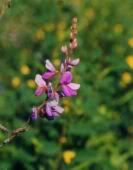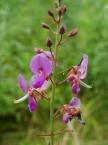

Scientific Name
Desmodium canadense
Uses of Showy Ticktrefoil: Landscaping, Medicinal, Culinary, etc...
Showy ticktrefoil is used for wildlife food and cover (quail, pheasants, turkey, ground birds, and deer), and as a small component in seeding mixtures for prairie restoration.
General Characteristics
Showy ticktrefoil is a tall (over 4 feet in height), native, perennial warm-season legume. Its leaves are clover-like, made up of 3 long-oval leaflets that are ½ to 4 inches long (usually 3 to 8 times as long as broad). The lower surface of the leaflets is covered with dense hairs; stems have fewer hairs. Showy ticktrefoil flowers are small and purple; the ½-inch blossoms occur in clusters atop hairy stems. Showy ticktrefoil is open-pollinated. Seed pods are flat, deeply lobed or jointed, the joints often breaking apart and adhering to clothing and to animals by means of small hooked hairs; the pods have three or more segments, resembling a flattened chain of beads. There are approximately 72,500 clean seeds in 1 pound of showy ticktrefoil.
The branched inflorescence with larger flowers that are rose-purple and change to blue with age distinguish Desmodium canadense from Desmodium illinoense, which has a single, terminal white-flowered inflorescence with few branches. D. canadense is also a more robust plant and has a seed pod with one straight margin and one curved margin.
Required Growing Conditions
Showy ticktrefoil occurs in prairies and wet meadows, along spring branches, and in open thickets. It ranges from Quebec to North Dakota and Saskatchewan, south to Virginia, West Virginia, Ohio, Indiana, Illinois, Missouri, and Oklahoma.
For a current distribution map, please consult the Plant Profile page for this species on the PLANTS Web site.
Cultivation and Care
Prepare a clean weed free seedbed by disking and harrowing. Firm the seedbed by cultipacking. The seedbed should be firm enough to allow the seed to be planted ¼ inch deep. Seeding rates for showy ticktrefoil should be about 3 to 4 pounds pure live seed (PLS) per acre for wildlife planting. Scarified inoculated (“EL” Culture) seed should always be used. Showy ticktrefoil is seeded at 0.5% to 1% of a total seed mixture for prairie restoration. A brillion seeder works well in the seeding operation, although other types of seeders or drills may be used. Showy ticktrefoil grows well on a wide range of soil types. Seed can be planted in the spring, early fall or dormant seeded in the winter. The seedlings are vigorous; therefore, new plantings can be established quickly. This makes showy ticktrefoil especially useful in mixtures with warm-season grasses, many of which do not produce ground cover rapidly. Apply no fertilizer the establishment year unless a soil test indicates a severe deficiency of potassium and/or phosphorus. Use no nitrogen during the establishment year as this can encourage weed competition.
General Upkeep and Control
Reduce weed competition by mowing at a height that will not affect the ticktrefoil seedlings. For grassy weed control use a grass herbicide and follow label recommendations, as herbicide weed control will encourage a good stand. Note: Some herbicide products may not be registered on this legume species in your state.
Pests and Potential Problems None known at this time.
Cultivars, Improved, and Selected Materials (and area of origin) Alexander Germplasm showy ticktrefoil is a source-identified release from the Elsberry, Missouri Plant Materials Center. It was collected from a native stand in Alexander County in southern Illinois.





0 comments: